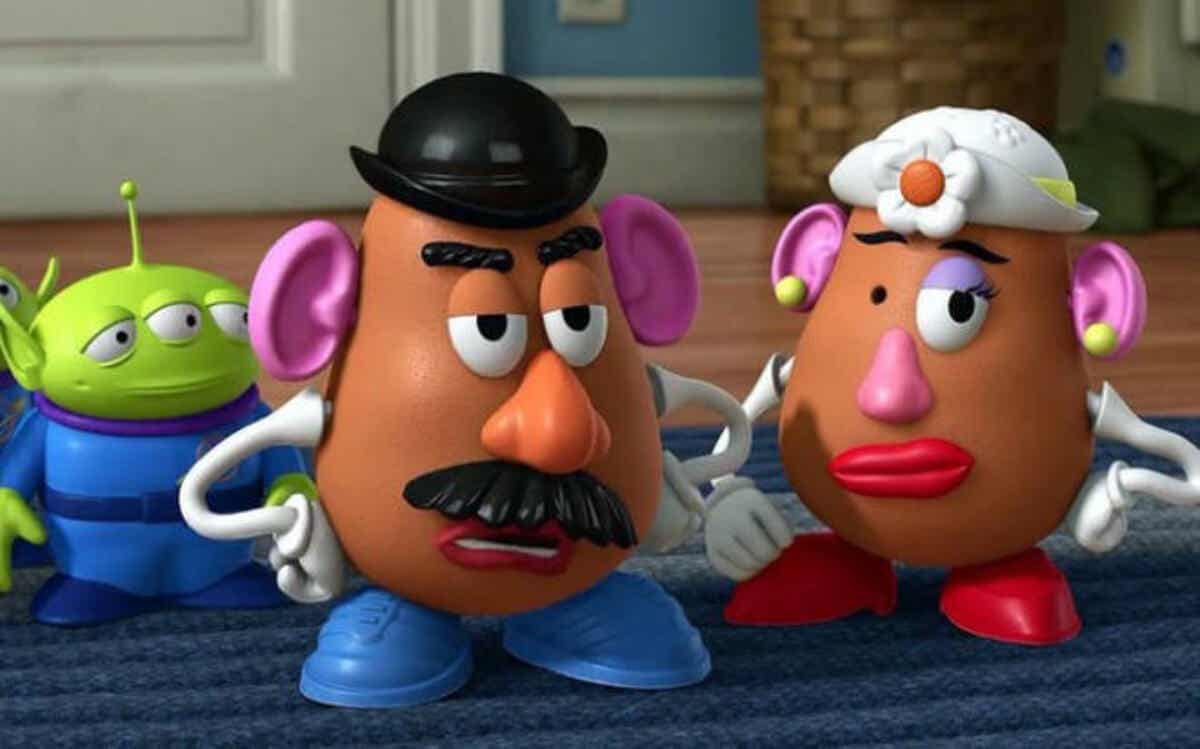Mr. Potato Head: a Toy that Promotes Child Development

Who doesn’t know Mr. Potato Head? Besides being one of the best characters in the movie Toy Story, this well-known toy with removable parts and the shape of a potato allows children to spend hours having fun. Alongside making new combinations with his face.
Furthermore, it’s not only a fun toy, it’s a perfect tool to stimulate different abilities and skills that promote children’s healthy development. But, what are we really talking about here? Next, we’ll explain it.
Mr. Potato Head: a toy that promotes child development
Mr. Potato Head is a wonderful toy that’s also an educational resource when working on different abilities and skills with children:
- Psychomotricity: when manipulating and fitting together the toy’s pieces (nose, mustache, eyes, hat, etc.), children develop their fine motor skills and eye-hand coordination. Besides, in order to form different faces, children must be able to dominate the body schema. In other words, they need to have a clear mental representation of the human body.
- Attention and concentration: in order to form different face combinations properly, children must spend time focusing and concentrating on the activity.
- Creativity: due to its interchangeable parts and accessories, children are able to stimulate their imagination and make creations. However, Mr. Potato Head isn’t only a toy built to change its face. In fact, children can make up stories and adventures for this wonderful character.
- Language and communication: by playing with Mr. Potato Head, children can learn vocabulary related to body parts and clothes. Furthermore, when making up stories, kids work on expression, language comprehension, and communication skills.
The curious story of Mr. Potato Head
Nowadays, everybody knows Mr. Potato Head. However, most people don’t know that George Lerner created it more than 70 years ago. Actually, it was created in 1949 and released to the market in 1952.
In the beginning, it wasn’t a potato-shaped toy with removable parts. Actually, the toy consisted of different plastic complements and accessories you could add to real potatoes and vegetables.
In 1965, the company released the toy’s body. Then, in 1995, when the movie Toy Story came out, Mr. Potato Head became really popular.
Over the past years, the toy evolved, including more accessories and releasing different versions of it, such as Star Wars, Spider-Man, Indiana Jones, Iron Man and, of course, Mrs. Potato Head.
“Play is our brain’s favorite way of learning”.
-Diane Ackerman-

When playing with this toy, children learn new things without even realizing it
Mr. Potato Head is the kind of toy children, parents and professionals love. Even though children only see it as a fun toy, they don’t realize it’s also quite educational for them. In fact, it stimulates their motor, cognitive and socio-communicative skills.
In addition, professional use this toy to work on children with neurodevelopmental disorders or learning disabilities.
As we’ve mentioned before, when playing with Mr. Potato Head, children learn new things without even realizing it. Finally, they become quite excited when realizing they have the exact toy that appears in the movie Toy Story.
Who doesn’t know Mr. Potato Head? Besides being one of the best characters in the movie Toy Story, this well-known toy with removable parts and the shape of a potato allows children to spend hours having fun. Alongside making new combinations with his face.
Furthermore, it’s not only a fun toy, it’s a perfect tool to stimulate different abilities and skills that promote children’s healthy development. But, what are we really talking about here? Next, we’ll explain it.
Mr. Potato Head: a toy that promotes child development
Mr. Potato Head is a wonderful toy that’s also an educational resource when working on different abilities and skills with children:
- Psychomotricity: when manipulating and fitting together the toy’s pieces (nose, mustache, eyes, hat, etc.), children develop their fine motor skills and eye-hand coordination. Besides, in order to form different faces, children must be able to dominate the body schema. In other words, they need to have a clear mental representation of the human body.
- Attention and concentration: in order to form different face combinations properly, children must spend time focusing and concentrating on the activity.
- Creativity: due to its interchangeable parts and accessories, children are able to stimulate their imagination and make creations. However, Mr. Potato Head isn’t only a toy built to change its face. In fact, children can make up stories and adventures for this wonderful character.
- Language and communication: by playing with Mr. Potato Head, children can learn vocabulary related to body parts and clothes. Furthermore, when making up stories, kids work on expression, language comprehension, and communication skills.
The curious story of Mr. Potato Head
Nowadays, everybody knows Mr. Potato Head. However, most people don’t know that George Lerner created it more than 70 years ago. Actually, it was created in 1949 and released to the market in 1952.
In the beginning, it wasn’t a potato-shaped toy with removable parts. Actually, the toy consisted of different plastic complements and accessories you could add to real potatoes and vegetables.
In 1965, the company released the toy’s body. Then, in 1995, when the movie Toy Story came out, Mr. Potato Head became really popular.
Over the past years, the toy evolved, including more accessories and releasing different versions of it, such as Star Wars, Spider-Man, Indiana Jones, Iron Man and, of course, Mrs. Potato Head.
“Play is our brain’s favorite way of learning”.
-Diane Ackerman-

When playing with this toy, children learn new things without even realizing it
Mr. Potato Head is the kind of toy children, parents and professionals love. Even though children only see it as a fun toy, they don’t realize it’s also quite educational for them. In fact, it stimulates their motor, cognitive and socio-communicative skills.
In addition, professional use this toy to work on children with neurodevelopmental disorders or learning disabilities.
As we’ve mentioned before, when playing with Mr. Potato Head, children learn new things without even realizing it. Finally, they become quite excited when realizing they have the exact toy that appears in the movie Toy Story.
All cited sources were thoroughly reviewed by our team to ensure their quality, reliability, currency, and validity. The bibliography of this article was considered reliable and of academic or scientific accuracy.
- Salamon, J. (2014). Focused Play Using Mr. Potato Head Toys to Improve Spontaneous Speech Production in Children Identified with Autism Spectrum Disorder. New Mexico State University.
This text is provided for informational purposes only and does not replace consultation with a professional. If in doubt, consult your specialist.








